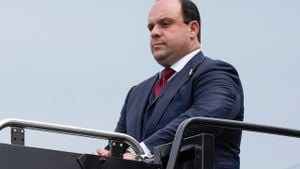NASA's decision to send the Boeing Starliner space capsule back to Earth without its two crew members marks yet another chapter of turbulence for Boeing’s space program. Launched with great expectations, the Starliner was intended to pave the way for routine crewed flights, yet the recent developments have caused quite the commotion.
Initially billed as the ultimate test to certify the Starliner for future missions, this mission quickly turned sour when NASA officials, after spending all summer analyzing telemetry data, determined the capsule's thrusters presented too much risk for the astronauts' safety. The harsh reality has now emerged: astronauts Butch Wilmore and Suni Williams, who were launched to the International Space Station (ISS) aboard the Starliner, will be making their way back home on SpaceX's Dragon spacecraft instead.
This decision has not only thrown Boeing's plans but also embarrassed many employees within the company. "We hate SpaceX," sighed one Boeing worker under anonymity, expressing the pain felt within the hallways of the aerospace giant, now turned rescue-seeker. What stings the most is knowing their competitive spirit is overshadowed by the image of SpaceX swooping in to save the day.
The astronauts were supposed to be back home earlier but are now expected to remain at the ISS for nearly six months longer than intended, residing over monthly supply allocations meant for other astronauts aboard the station. It's estimated to be back on Earth no sooner than February 2025, creating uncertainty and extended pressure for all involved.
Fears over the reliability of the Starliner’s thrusters have deep roots concerning the agency’s safety culture. NASA Administrator Bill Nelson linked the agency's decision-making to lessons learned from historical tragedies, namely the Challenger and Columbia shuttle disasters. Both incidents brought to light serious issues when safety protocols were not strictly adhered to, leading to loss of lives.
“The lessons learned from Challenger and Columbia weigh heavily on our decisions today,” Nelson stated during the press conference announcing the crew change—with safety cited as the utmost priority. Concerns about the reliability of Starliner’s thrusters grew sufficiently dire for NASA to mandate another path home. Stepping away from their initial plans, NASA felt compelled to choose safety over pride and ambition.
If there’s one thing that's clear, it’s the atmosphere of uncertainty surrounding Starliner itself. NASA Associate Administrator Jim Free noted the difficulties they faced: “We still have some work to do,” he remarked, drawing attention to unresolved physics issues with the thrusters. These issues left room for concerns about the vehicle's operational integrity.
This latest twist isn't merely procedural; it’s indicative of what’s been dubbed the “Boeing blues.” With Boeing’s reputation already battered due to multiple flight incidents earlier this year, employees express feelings of demoralization, as competition shapes within the aerospace industry like never before. For many, returning crew members on SpaceX’s Dragon is tantamount to admitting defeat.
SpaceX, for its part, continues to make headlines of its own. The company is gearing up for upcoming missions, including its historic Polaris Dawn launch, which aims to take private astronauts farther than any human has gone since the Apollo era. With multiple successful crewed missions under its belt, SpaceX seems poised to triumph where Boeing falters.
So what does the future hold for Boeing? Under the helm of new CEO Kelly Ortberg, the question remains whether the company will invest more resources to salvage its tarnishing image or dissolve its Starliner project altogether. Analysts are skeptical, with some predicting Boeing could be forced to withdraw from the space sector altogether if they cannot get it right.
Boeing’s entire space unit has also faced staff blight, with many skilled engineers and designers opting for shifts to competitors like SpaceX and Jeff Bezos’ Blue Origin. The legacy of perceived inefficiency is palpable, wherein the less nimble operations seem stuck behind those of SpaceX's vertical operations.
Returning to the key players—astronauts Wilmore and Williams are embedded within the ISS team, applying their skills to various research undertakings; yet, their time spent up there continues to impose operational strains on the entire crew. Wilmore and Williams were expecting to return after only eight days but have now boarded the expedition for what may feel more like eight months.
While SpaceX remains on track to achieve its next ambitious goals, NASA and Boeing find themselves scrambling to stabilize their plans. Boeing will work to retrieve the uncrewed Starliner back to Earth, envisaging to have it land sometime between September and November. Adjustments have also been made to Crew-9 mission plans, wherein life will function along two astronauts instead of the usual four, making room for the Starliner astronauts.
This situation calls attention—apart from the ramifications for Boeing’s standing within the aerospace community but also within the fabric of NASA's commitment to protecting its workforce. The stakes are high, with operational credibility following them closely.
Both organizations and Senator Nelson remain steadfast, focusing on lessons learned and operational ethos revolving around safety and transparency. The hope, as always, is to prevent history from repeating itself. The reverberations stemming from the tragedies of the past echo loud and clear as they chart the uncertain paths forward amid swirling challenges.
It is clear now, more than ever, NASA and Boeing are left at an existential crossroads, needing to double down their efforts, calibrate their approach structurally, and recover what they can of their tarnished legacies.
The world watches with bated breath, as missions continue, future astronauts toy with the reality of living elevated lives beyond the constraints of gravity, and bureaucracies crash beneath the weight of public scrutiny.



